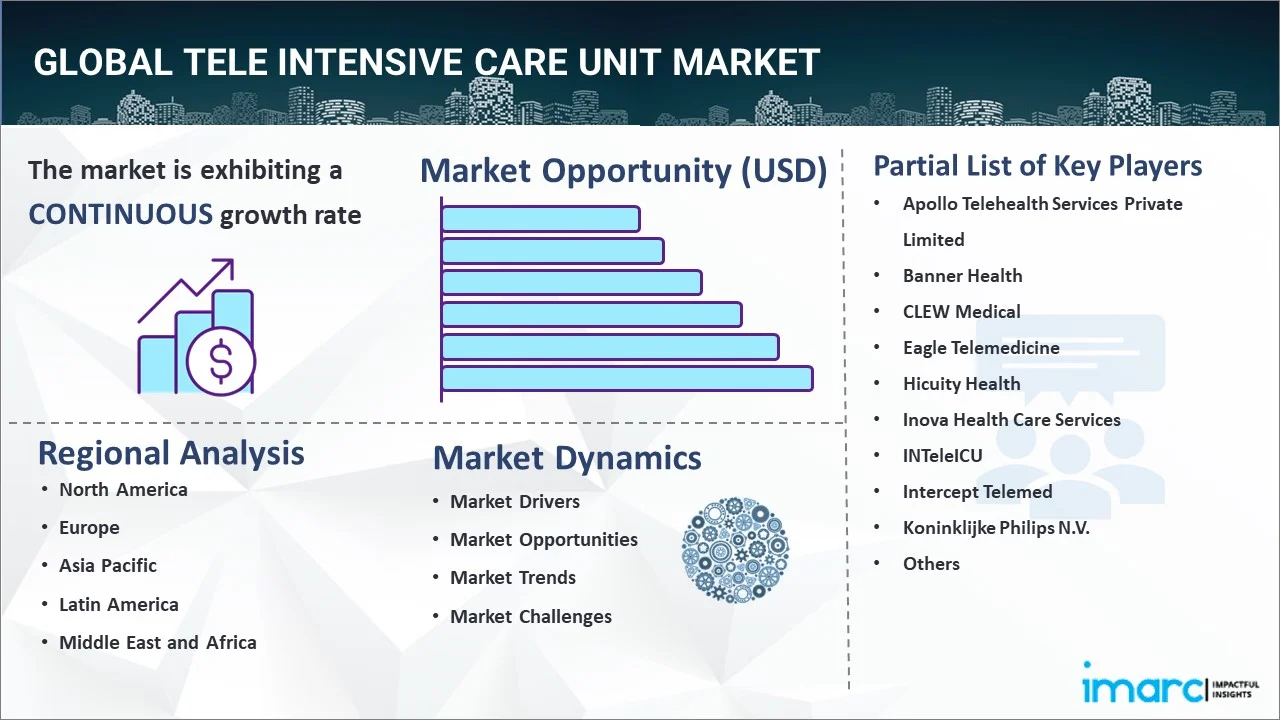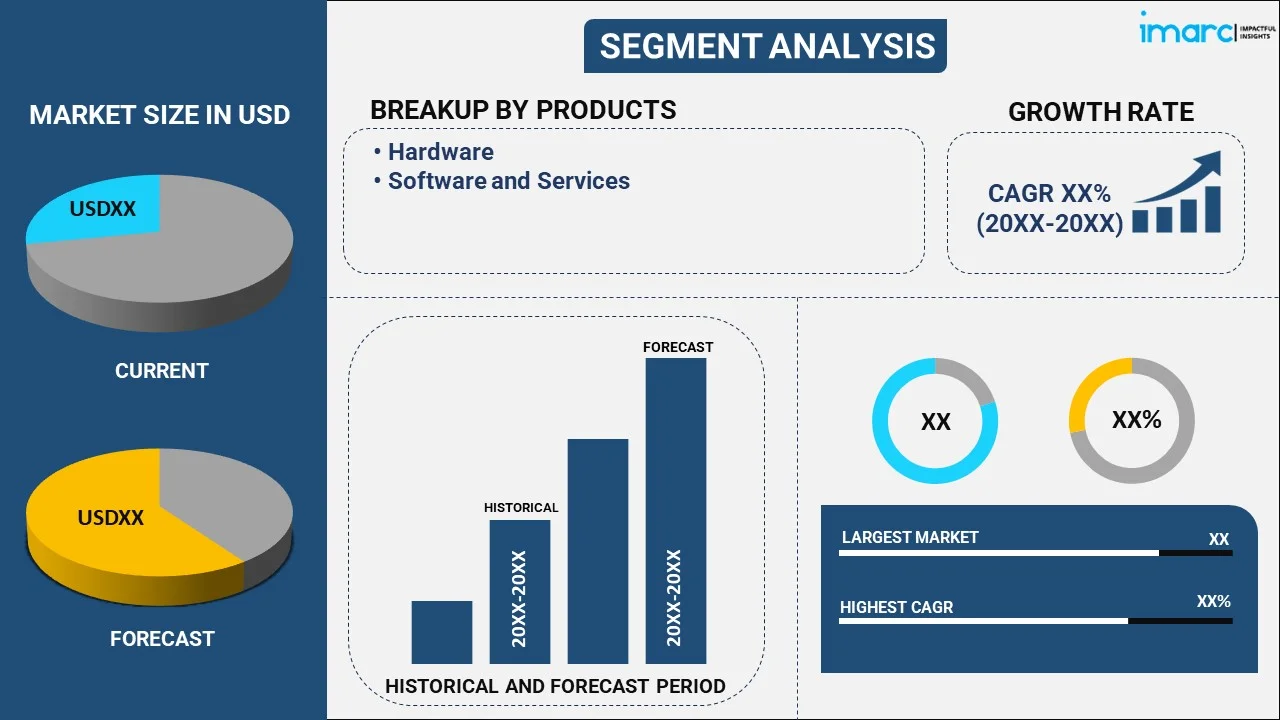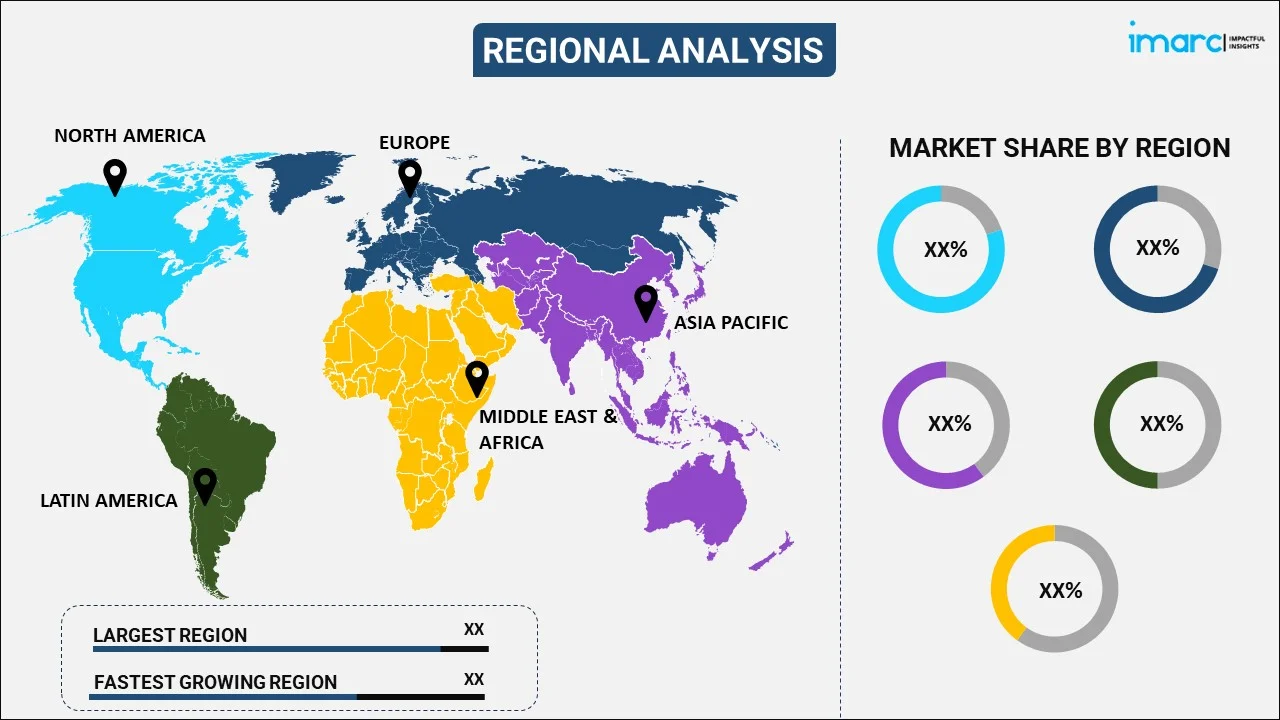
Tele Intensive Care Unit Market Report by Component (Hardware, Software and Services), Type (Centralized Models, Decentralized Models), End User (Hospitals, Clinics, and Others), and Region 2025-2033
Market Overview:
The global tele intensive care unit market size reached USD 6.5 Billion in 2024. Looking forward, IMARC Group expects the market to reach USD 19.7 Billion by 2033, exhibiting a CAGR of 12.43% during 2025-2033. The market growth is robust, primarily driven by the rising demand for advanced remote monitoring and patient management solutions. Innovations in IoT and AI technologies and the need for cost-effective, scalable intensive care, are significantly enhancing market demand globally.
|
Report Attribute
|
Key Statistics
|
|---|---|
|
Base Year
|
2024
|
|
Forecast Years
|
2025-2033
|
|
Historical Years
|
2019-2024
|
|
Market Size in 2024
|
USD 6.5 Billion |
|
Market Forecast in 2033
|
USD 19.7 Billion |
| Market Growth Rate 2025-2033 | 12.43% |
Tele intensive care unit (tele ICU) refers to an application of telemedicine that aids in the interaction of the critical care team at a distant location with the bedside ICU crew via audio-visual communication and monitoring systems. The medical data collected and transmitted by this ICU system primarily comprise of patients' physiological status, medications, and past records. Tele ICU increases efficiency in healthcare delivery and enables real-time access to the patient's clinical information. As a result, these ICUs are being widely adopted in hospitals, treatment centers, advanced clinics, etc.

Tele Intensive Care Unit Market Trends:
Growing Prevalence of Chronic and Acute Diseases
The rising incidence of chronic illnesses and acute conditions necessitates advanced intensive care solutions. As populations age and lifestyle-related diseases become more common, healthcare systems face increasing pressure to manage complex patient cases effectively. According to an article published by the Centers for Disease Control and Prevention in 2024, in the United States, approximately 129 million people have at least one major chronic disease. About 42% have two or more chronic conditions, and 12% have at least five, accounting for 90% of USD 4.1 trillion health care costs. Tele ICU systems provide the necessary support by enabling continuous remote monitoring and real-time data analysis, which enhances the ability to respond swiftly to patient needs. These systems facilitate specialized care coordination, allowing critical care experts to oversee multiple patients simultaneously and intervene promptly when complications arise. Consequently, tele ICU implementations lead to improved survival rates, reduced hospital stays, and enhanced patient outcomes by ensuring that high-quality intensive care is accessible even in resource-limited settings.
Integration of Advanced Technologies
Artificial Intelligence (AI) and Machine Learning (ML) are revolutionizing tele ICU systems by enhancing predictive analytics, patient monitoring, and decision support. These technologies analyze vast amounts of patient data in real-time, enabling the early detection of signs indicating patient deterioration. By identifying patterns and predicting potential complications, AI and ML allow healthcare providers to intervene proactively, thereby optimizing treatment protocols. For instance, in July 2024, Cleveland Clinic partnered with Masimo to enhance remote patient monitoring and virtual critical care. The initiative focuses on integrating monitoring platforms and AI-driven analytics to improve clinical decision support for hospitalized patients. Additionally, these advanced technologies support personalized care plans, improve resource allocation, and reduce human error, ultimately leading to better patient outcomes and more efficient intensive care management.
Expansion of IoT and Remote Monitoring
The proliferation of Internet of Things (IoT) devices is revolutionizing Tele ICU systems by enabling continuous remote monitoring of vital signs and other critical health parameters. These interconnected devices collect real-time data, such as heart rate, blood pressure, and oxygen levels, and transmit it seamlessly to healthcare providers. This constant stream of information allows for timely interventions, reducing the risk of complications and enhancing patient outcomes. Additionally, IoT integration facilitates predictive analytics, helping clinicians anticipate and address potential issues before they escalate. By improving data accuracy and accessibility, IoT-driven remote monitoring significantly elevates the overall quality of care in intensive care settings, ensuring patients receive prompt and personalized treatment. These advancements are expanding the tele intensive care unit market share, as healthcare providers increasingly adopt IoT-enabled solutions to enhance patient care and operational efficiency.
Key Market Segmentation:
IMARC Group provides an analysis of the key trends in each sub-segment of the global tele intensive care unit market report, along with forecasts at the global, regional and country level from 2025-2033. Our report has categorized the market based on component, type and end user.
Breakup by Component:

- Hardware
- Therapeutic Devices
- Communication Lines
- Computer Systems
- Physiological Monitors
- Display Panels
- Video Feed
- Other
- Software and Services
Breakup by Type:
- Centralized Models
- Decentralized Models
Breakup by End User:
- Hospitals
- Clinics
- Others
Breakup by Region:

- North America
- United States
- Canada
- Asia-Pacific
- China
- Japan
- India
- South Korea
- Australia
- Indonesia
- Others
- Europe
- Germany
- France
- United Kingdom
- Italy
- Spain
- Russia
- Others
- Latin America
- Brazil
- Mexico
- Others
- Middle East and Africa
Competitive Landscape:
The report has also provided a comprehensive analysis of the competitive landscape in the global tele intensive care unit market. Detailed profiles of all major companies have also been provided. Some of the companies covered include:
- Apollo Telehealth Services Private Limited
- Banner Health
- CLEW Medical
- Eagle Telemedicine
- Hicuity Health
- Inova Health Care Services
- INTeleICU
- Intercept Telemed
- Koninklijke Philips N.V.
- Soc Telemed Inc.
- Teladoc Health Inc.
- T-ICU Co. Ltd.
- University of Pittsburgh Medical Center
Kindly note that this only represents a partial list of companies, and the complete list has been provided in the report.
Tele Intensive Care Unit Market News:
- In June 2024, the University of Alabama at Birmingham (UAB) announced its partnership with Whitfield Regional Hospital to launch its first Tele-ICU expanded hospital in the state. This collaboration provides 24/7 remote monitoring of Whitfield’s eight-bed ICU by UAB's experienced team, enhancing patient care closer to home.
- In August 2024, Aster DM Healthcare launched Tele-ICU services, enhancing critical care across India. This technology-driven initiative provides 24/7 support from expert intensivists, facilitating remote monitoring and virtual consultations. The service aims to improve patient outcomes, especially in underserved areas, with successful interventions already documented in several cases.
- In April 2024, HealthNet Global (HNG) and Apollo Spectra Hospitals launched a groundbreaking Tele-ICU program at Apollo Spectra. The initiative, featuring remote monitoring and expert intervention, aims to enhance critical care access, especially in rural areas.
Report Coverage:
| Report Features | Details |
|---|---|
| Base Year of the Analysis | 2024 |
| Historical Period | 2019-2024 |
| Forecast Period | 2025-2033 |
| Units | Billion USD |
| Segment Coverage | Component, Type, End User, Region |
| Region Covered | Asia Pacific, Europe, North America, Latin America, Middle East and Africa |
| Countries Covered | United States, Canada, Germany, France, United Kingdom, Italy, Spain, Russia, China, Japan, India, South Korea, Australia, Indonesia, Brazil, Mexico |
| Companies Covered | Apollo Telehealth Services Private Limited, Banner Health, CLEW Medical, Eagle Telemedicine, Hicuity Health, Inova Health Care Services, INTeleICU, Intercept Telemed, Koninklijke Philips N.V., Soc Telemed Inc., Teladoc Health Inc., T-ICU Co. Ltd., University of Pittsburgh Medical Center |
| Customization Scope | 10% Free Customization |
| Post-Sale Analyst Support | 10-12 Weeks |
| Delivery Format | PDF and Excel through Email (We can also provide the editable version of the report in PPT/Word format on special request) |
Key Questions Answered in This Report
The global tele intensive care unit market was valued at USD 6.5 Billion in 2024.
We expect the global tele intensive care unit market to exhibit a CAGR of 12.43% during 2025-2033.
The sudden outbreak of the COVID-19 pandemic has led to the increasing deployment of tele ICUs to establish a centralized remote patient monitoring system that provides high-quality patient care, reduces transfers while maximizing bed utilization, supports healthcare professionals, etc.
The rising adoption of tele ICUs for enhancing patient care, reducing the length of hospital stays, improving recovery period, facilitating efficient healthcare delivery, etc., is primarily driving the global tele intensive care unit market.
Based on the component, the global tele intensive care unit market can be categorized into hardware and software and services. Currently, hardware accounts for the majority of the global market share.
Based on the type, the global tele intensive care unit market has been segregated into centralized models and decentralized models, where centralized currently holds the largest market share.
Based on the end user, the global tele intensive care unit market can be bifurcated into hospitals, clinics, and others. Among these, hospitals exhibit a clear dominance in the market.
On a regional level, the market has been classified into North America, Asia-Pacific, Europe, Latin America, and Middle East and Africa, where North America currently dominates the global market.
Some of the major players in the global tele intensive care unit market include Apollo Telehealth Services Private Limited, Banner Health, CLEW Medical, Eagle Telemedicine, Hicuity Health, Inova Health Care Services, INTeleICU, Intercept Telemed, Koninklijke Philips N.V., Soc Telemed Inc., Teladoc Health Inc., T-ICU Co. Ltd., and University of Pittsburgh Medical Center.
Need more help?
- Speak to our experienced analysts for insights on the current market scenarios.
- Include additional segments and countries to customize the report as per your requirement.
- Gain an unparalleled competitive advantage in your domain by understanding how to utilize the report and positively impacting your operations and revenue.
- For further assistance, please connect with our analysts.
 Inquire Before Buying
Inquire Before Buying
 Speak to an Analyst
Speak to an Analyst
 Request Brochure
Request Brochure
 Request Customization
Request Customization




.webp)




.webp)












